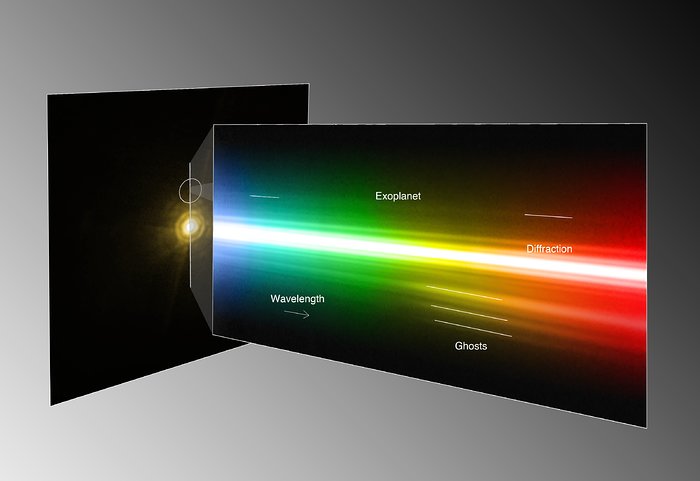Spectrum of the planet around HR 8799 (annotated)
By studying a triple planetary system that resembles a scaled-up version of our own Sun’s family of planets, astronomers have been able to obtain the first direct spectrum of a planet around a star, thus bringing new insights into its formation and composition.The spectrum is that of a giant exoplanet, orbiting around the bright and very young star HR 8799, about 130 light-years away. This montage shows the image and the spectrum of the star and the planet as seen with the NACO adaptive optics instrument on ESO’s Very Large Telescope. As the host star is several thousand times brighter than the planet, this is a remarkable achievement at the border of what is technically possible. According to the scientists it is like trying to see what a candle is made of, by observing it from a distance of two kilometres when it’s next to a blindingly bright 300 Watt lamp. Despite the power of the VLT’s extraordinary adaptive optics system, the spectrum of the planet appears very faint, but still contains enough information for the astronomers to characterise the object. In the spectrum (right) several artefacts from the instrument are seen, such as internal reflections, or “ghosts”, and diffraction rings. Similarly, the image of the star (left) suffers from several diffraction artefacts, which should not be confused with the real signal of the exoplanet.
Credit:ESO/M. Janson
Over de afbeelding
| Id: | eso1002a |
| Type: | Collage |
| Publicatiedatum: | 13 januari 2010 12:00 |
| Gerelateerde berichten: | eso1002 |
| Grootte: | 3200 x 2200 px |
Over het object
| Naam: | HR 8799 |
| Type: | Milky Way : Star : Evolutionary Stage : Young Stellar Object |
| Afstand: | 130 lichtjaren |
| Categorie: | Illustrations |
Kleuren & filters
| Band | Telescoop |
|---|---|
| Infrarood Near-IR | Very Large Telescope NACO |
